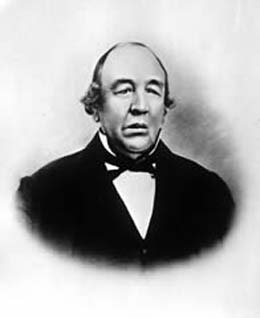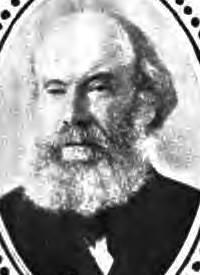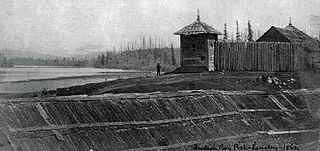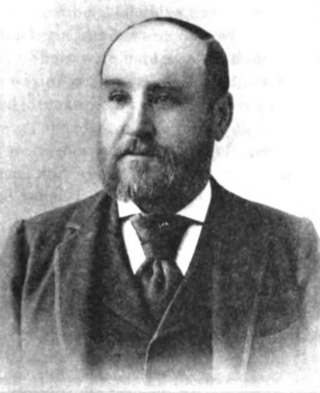Vancouver is the most populous city in British Columbia, Canada.

John McLoughlin, baptized Jean-Baptiste McLoughlin, was a French-Canadian, later American, Chief Factor and Superintendent of the Columbia District of the Hudson's Bay Company at Fort Vancouver from 1824 to 1845. He was later known as the "Father of Oregon" for his role in assisting the American cause in the Oregon Country. In the late 1840s, his general store in Oregon City was famous as the last stop on the Oregon Trail.

The first USS Shark was a schooner in the United States Navy. Built in the Washington Navy Yard to the designs of Henry Steers, Shark was launched on 17 May 1821. On 11 May 1821, Matthew C. Perry was ordered to take command of Shark, and the ship was ready to receive her crew on 2 June 1821.

John Work was a Chief Factor of the Hudson's Bay Company and head of one of the original founding families in Victoria, British Columbia. Work joined the Hudson's Bay Company in 1814 and served in many capacities until his death in 1861, ultimately becoming a member of the company's Board of Management for its Western Department. He also served on Vancouver Island's Legislative Council. At the time of his death, Work was the largest private land owner of Vancouver Island. Work left an important legacy in the form of sixteen journals which chronicle his trading expeditions from 1823 to 1851. His journals provide a detailed record of Pacific Northwest land features, native peoples, and the Hudson's Bay Company's fur trading business in the early 19th century.

Fort Nisqually was an important fur trading and farming post of the Hudson's Bay Company in the Puget Sound area, part of the Hudson's Bay Company's Columbia Department. It was located in what is now DuPont, Washington. Today it is a living history museum located in Tacoma, Washington, USA, within the boundaries of Point Defiance Park. The Fort Nisqually Granary, moved along with the Factor's House from the original site of the second fort to this park, is a U.S. National Historic Landmark. Built in 1843, the granary is the oldest building in Washington state and one of the only surviving examples of a Hudson's Bay Company "post-and-plank" structure. The Factor's House and the granary are the only surviving Hudson's Bay Company buildings in the United States.

The Columbia District was a fur trading district in the Pacific Northwest region of British North America in the 19th century. Much of its territory overlapped with the disputed Oregon Country. It was explored by the North West Company between 1793 and 1811, and established as an operating fur district around 1810. The North West Company was absorbed into the Hudson's Bay Company in 1821 under which the Columbia District became known as the Columbia Department. The Oregon Treaty of 1846 marked the effective end of the Hudson's Bay Company's Columbia Department.

Cadboro Bay is a bay near the southern tip of Vancouver Island and its adjacent neighbourhood in the municipalities of Saanich and Oak Bay in Greater Victoria, British Columbia, Canada.
The Puget Sound Agricultural Company (PSAC), with common variations of the name including Puget Sound or Puget's Sound, was a subsidiary joint stock company formed in 1840 by the Hudson's Bay Company (HBC). Its stations operated within the Pacific Northwest, in the HBC administrative division of the Columbia Department. The RAC-HBC Agreement was signed in 1839 between the Russian-American Company and the HBC, with the British to now supply the various trade posts of Russian America. It was hoped by the HBC governing committee that independent American merchants, previously a major source of foodstuffs for the RAC, would be shut out of the Russian markets and leave the Maritime fur trade.

William Fraser Tolmie was a surgeon, fur trader, scientist, and politician.

James McMillan was a fur trader and explorer for the North West Company and Hudson's Bay Company. He led some of the earliest surveys of the lower Fraser River and founded Fort Langley for the HBC in 1827, and was its first Chief Trader.
William Henry McNeill was best known for his 1830 expedition as the captain of the brig Llama, which sailed from Boston, Massachusetts, United States, 12,000 miles (19,000 km) around Cape Horn, to the Pacific Northwest on a maritime fur trade expedition.
George Barnston was a fur trader and a naturalist born in Edinburgh, Scotland.

The York Factory Express, usually called "the Express" and also the Columbia Express and the Communication, was a 19th-century fur brigade operated by the Hudson's Bay Company (HBC). Roughly 4,200 kilometres (2,600 mi) in length, it was the main overland connection between HBC headquarters at York Factory and the principal depot of the Columbia Department, Fort Vancouver.
Vancouver was a barque built and operated by the Hudson's Bay Company to serve on the route between London, England and Fort Victoria on Vancouver Island in what is now the province of British Columbia, Canada. Other vessels committed to the route were Columbia and Cowlitz, but Vancouver was the first of the three to enter Victoria harbour, and the first vessel to sail directly from England to enter that port, in 1845. Other vessels in the company's service were Nereid and Cadboro.
Duke of York was a three-masted brig launched in 1817 at Bideford as a Falmouth packet, sailing between Falmouth, Cornwall, and Jamaica. In 1836 she brought settlers to South Australia for the South Australia Company. She was wrecked in 1837.
William Alexander Mouat was a British seafarer. Born in London, he spent much of his career with the Hudson's Bay Company in British Columbia on the west coast of Canada. He became master of several merchant ships including the Otter and the Labouchere. His last posting was at Fort Rupert where he died in a canoe accident. He was married to Mary Ann Ainsley and they had eight children.

Edward Huggins was a Hudson's Bay Company clerk, Pierce County commissioner, Pierce County auditor, and historian of the Northwestern United States. The Fort Nisqually Living History Museum has a collection of items related to Huggins.
Isabella was launched in 1825 at Shoreham. Initially, she traded with Gibraltar and Honduras. The Hudson's Bay Company (HBC) purchased her in 1829 and she was wrecked in 1830 on the Columbia River bar off Clatsop County, Oregon. The site of her remains are on the National Register of Historic Places in Clatsop County, Oregon as #89001385 placed on September 21, 1989. The remains are owned by the State of Oregon, Division of State Lands after being found in 1986. She is a wooden ship with copper sheathing.
William and Ann was launched in Bermuda in 1818. In 1824 the Hudson's Bay Company (HBC) purchased William and Ann. In 1825 she became the first HBC vessel to trade with the Pacific Northwest, competing directly with the Boston fur traders. She made three voyages to Fort George on the Columbia River, and was lost on 10 March 1829 on her fourth as she was arriving there.











